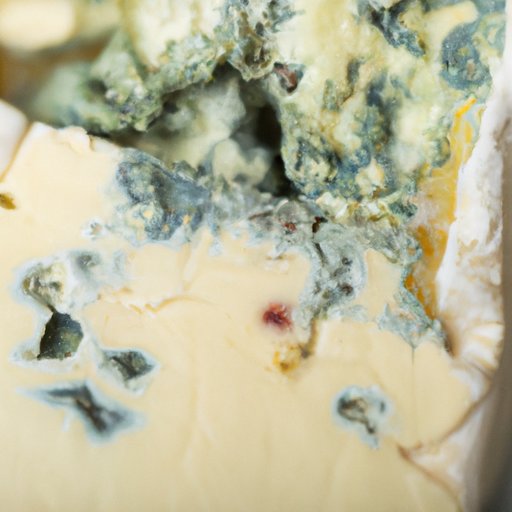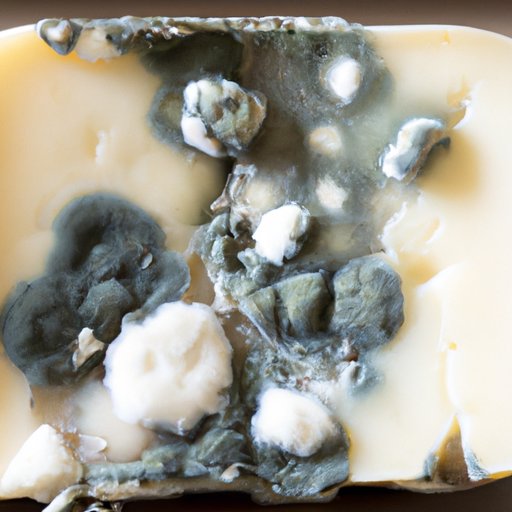
Introduction
Have you ever come across a piece of cheese that looks a little fuzzy or covered in spots? That’s mold, and it’s a common problem, especially when it comes to cheese. But what happens if you eat moldy cheese? Is it safe or harmful to your health? In this article, we will explore the potential risks of consuming moldy cheese, the science behind mold and cheese, and even some recipes to use up cheese that has gone a bit moldy.
The Health Implications of Consuming Moldy Cheese
The thought of eating mold might make many people feel queasy, and for good reason. Consuming moldy cheese can have potential risks to your health, depending on the type of mold and your body’s reaction to it. Some molds produce mycotoxins, which can cause mild symptoms such as nausea, vomiting, or upset stomach. In rare cases, mycotoxins can lead to more severe illnesses like allergic reactions or neurological problems.
There are thousands of types of mold, but not all of them are harmful to our health. Some molds are even used intentionally in the cheese-making process to develop specific flavors and textures. However, other molds can indicate that the cheese is contaminated with bacteria, which could cause food poisoning or other infections. The most common molds found on cheese include Penicillium, Aspergillus, Cladosporium, and Alternaria.
To avoid eating moldy cheese, it’s essential to know how to identify it. Keep an eye out for visible mold, which may appear as white, blue, green, or black spots or fuzz on the cheese’s surface. If the mold has penetrated deep into the cheese, it may have a distinct smell or bitterness.

The Dangers of Consuming Moldy Cheese for People with Compromised Immune Systems
For some people, eating moldy cheese can be particularly dangerous. People with weakened immune systems, such as those with HIV/AIDS, cancer, or autoimmune diseases, are especially vulnerable to mold-related illnesses. These individuals are more likely to experience severe symptoms, such as respiratory problems, organ failure, or even death, from consuming moldy foods. Mold can exacerbate their existing conditions and cause infections or inflammation.
The Science Behind Mold and Cheese
The relationship between mold and cheese is more complex than you might think. Mold plays a vital role in cheese-making, as certain types of molds give some cheeses their unique flavor profiles and textures. For example, blue cheese gets its distinct blue-green veins from Penicillium roqueforti, while brie has a soft, velvety rind thanks to Penicillium candidum.
The science behind mold and cheese boils down to three factors: the type of mold, the conditions in which the mold grows, and the type of cheese. In some cases, mold can enhance the cheese’s flavors and textures, but in others, it can spoil the cheese. The cheese-making process itself can affect mold growth, as certain factors like temperature, moisture, and oxygen can encourage or discourage mold growth.
Recipes to Use Up Moldy Cheese
If you’ve got some moldy cheese hanging out in your fridge, don’t throw it away just yet! You can still put it to good use in creative ways. Since moldy cheese can have a sharp, funky taste, it can add an extra layer of flavor to your dishes. Try crumbling it into an omelet or frittata for breakfast, melting it into casseroles or mac and cheese for lunch, or using it as a topper for soups or salads.
The History of Moldy Cheese and Its Role in Various Cultures
Moldy cheese may seem like a modern invention, but it has been around for centuries. Cheesemakers from different cultures have been using molds intentionally to create unique cheeses for generations. For example, Roquefort cheese from France is made with Penicillium roqueforti and has a soft, creamy texture with a pungent flavor, while Gorgonzola cheese from Italy has a blue-green veining and a sweet, tangy taste. In many cultures, cheese is a staple food and consumed regularly, even with mold present.
How to Prevent Mold from Growing on Cheese
The best way to avoid eating moldy cheese is to prevent mold from growing in the first place. To do so, you can store cheese in the refrigerator’s coldest part, usually the bottom drawer. Make sure to wrap it tightly in plastic wrap or foil, which can help prevent moisture buildup and prevent bacteria from spreading. For softer cheeses like brie or Camembert, it’s best to store them in their original packaging until you’re ready to eat them. Avoid touching the cheese with your bare hands, as bacteria from your skin can encourage mold growth. Lastly, clean the cheese knife after each use, and discard any cheese that has visible mold on it.
Conclusion
So what happens if you eat moldy cheese? It depends on the type of mold present, your health condition, and how your body reacts to it. While moldy cheese can be a potential health risk, understanding the science behind mold and cheese can help you make informed decisions about what to eat. By using moldy cheese creatively in recipes, learning about the cultural history of moldy cheese, and taking preventative measures to avoid mold growth in the future, you can still enjoy cheese without compromising your health.
Final tips: If you’re concerned about mold or experience any symptoms from eating moldy cheese, contact your healthcare provider to get advice. When in doubt, throw it out.




